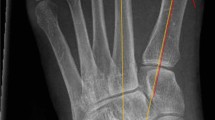Abstract
Introduction
Heel pain is one of the common reasons why patients consult orthopaedic surgeons in an outpatient setting. The dorsal heel pain is often caused by a Haglund’s deformity which is an exostosis of the posterior superior calcaneus. It often leads to Haglund’s syndrome with calcaneal bursitis and Achilles tendinosis. This study aims to investigate the roll of MRI in diagnosis of Haglund’s syndrome and its influence on therapy.
Materials and methods
We retrospectively analysed data of 45 patients which clinically and radiologically confirmed Haglund’s deformity. Patients were divided into two groups that either did not receive MRI (MRI_0) or received MRI (MRI_1). To evaluate the significance, Fisher´s test was used. A statistical significance was assumed at p < 0.05.
Results
The average age was 57.0 years. There was no significant difference in therapy comparing the groups MRI_0 and MRI_1. Haglund’s syndrome was detected in 86.7% of all patients with Haglund’s deformity.
Conclusion
MRI does not influence the therapy of patients with Haglund’s deformity. Therefore, the resources of this cost-intensive and limited type of investigation should be used elsewhere. In cases of atypical heel pain, the MRI might be useful.

Similar content being viewed by others
References
Irving DB, Cook JL, Menz HB (2006) Factors associated with chronic plantar heel pain: a systematic review. J Sci Med Sport 9(1–2):11–22 (discussion 23–4)
Tu P, Heel pain: diagnosis and management. Am Fam Phys 97(2):86–93
Vaishya R et al (2016) Haglund’s syndrome: a commonly seen mysterious condition. Cureus 8(10):e820
Thomas JL et al (2016) The diagnosis and treatment of heel pain: a clinical practice guideline-revision 2010. J Foot Ankle Surg. 49(3 Suppl):S1–S19
Chimutengwende-Gordon M, O’Donnell P, Singh D (2010) A comparative analysis of analgesic efficacy of ultrasound and Magnetic resonance imaging in plantar heel pain. Foot Ankle Int. 31(10):865–70
Krukowska J et al. (2016) A comparative analysis of analgesic efficacy of ultrasound and shock wave therapy in the treatment of patients with inflammation of the attachment of the plantar fascia in the course of calcaneal spurs. Arch Orthop Trauma Surg. 136(9):1289–1296
McNally EG, Shetty S (2010) Plantar fascia: imaging diagnosis and guided treatment. Semin Musculoskelet Radiol. 14(3):334–343
Tu P, Bytomski JR. Diagnosis of heel pain. Am Fam Phys 84(8):909–916
Adigo AM et al., Haglund deformity: report of three cases. Pan Afr Med J. 22: p. 37
Jimenez Martin F et al. Haglund’s syndrome. Two case reports. Reumatol Clin. 13(1):37–38
Kang S, Thordarson DB, Charlton TP (2012) Insertional achilles tendinitis and Haglund’s deformity. Foot Ankle Int. 33(6):487–491
Bulstra GH, van Rheenen TA, Scholtes VA (2015) Can we measure the heel bump? Radiographic evaluation of Haglund’s deformity. J Foot Ankle Surg. 54(3):338–340
van Beek EJR et al. Value of MRI in medicine: More than just another test? J Magn Reson Imaging
Fazal MA, Tsekes D, Baloch I (1997) Is there a role for MRI in plantar heel pain. Foot Ankle Spec. 11(3):242–245
Feydy A et al. (2012) Comparative study of MRI and power Doppler ultrasonography of the heel in patients with spondyloarthritis with and without heel pain and in controls. Ann Rheum Dis 71(4):498–503
Leitze Z, Sella EJ, Aversa JM (2003) Endoscopic decompression of the retrocalcaneal space. J Bone Joint Surg Am 85-A(8):1488–1496
Lohrer H, David S, Nauck T (2016) Surgical treatment for achilles tendinopathy—a systematic review. BMC Musculoskelet Disord 17:207
Lohrer H, Nauck T (2014) Results of operative treatment for recalcitrant retrocalcaneal bursitis and midportion Achilles tendinopathy in athletes. Arch Orthop Trauma Surg. 134(8):1073–81
Funding
There is no funding source.
Author information
Authors and Affiliations
Corresponding author
Ethics declarations
Conflict of interest
The authors declare that they have no conflict of interest.
Ethical approval
This article does not contain any studies with human participants or animals performed by any of the authors.
Rights and permissions
About this article
Cite this article
Debus, F., Eberhard, HJ., Olivieri, M. et al. MRI in patients with Haglund’s deformity and its influence on therapy. Arch Orthop Trauma Surg 139, 903–906 (2019). https://doi.org/10.1007/s00402-019-03122-w
Received:
Published:
Issue Date:
DOI: https://doi.org/10.1007/s00402-019-03122-w




